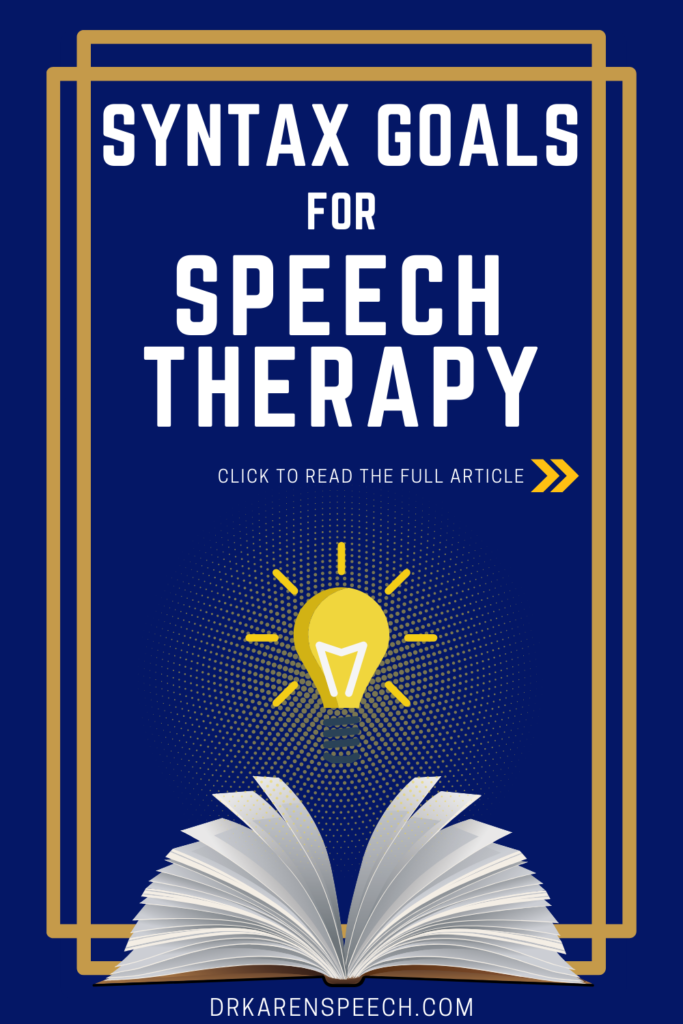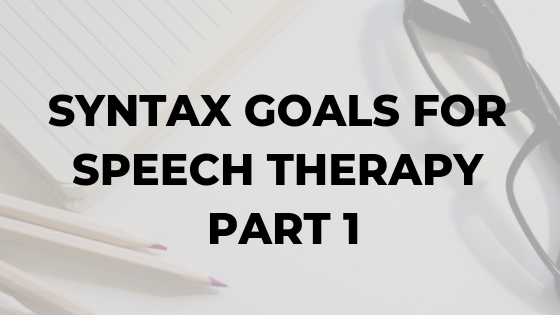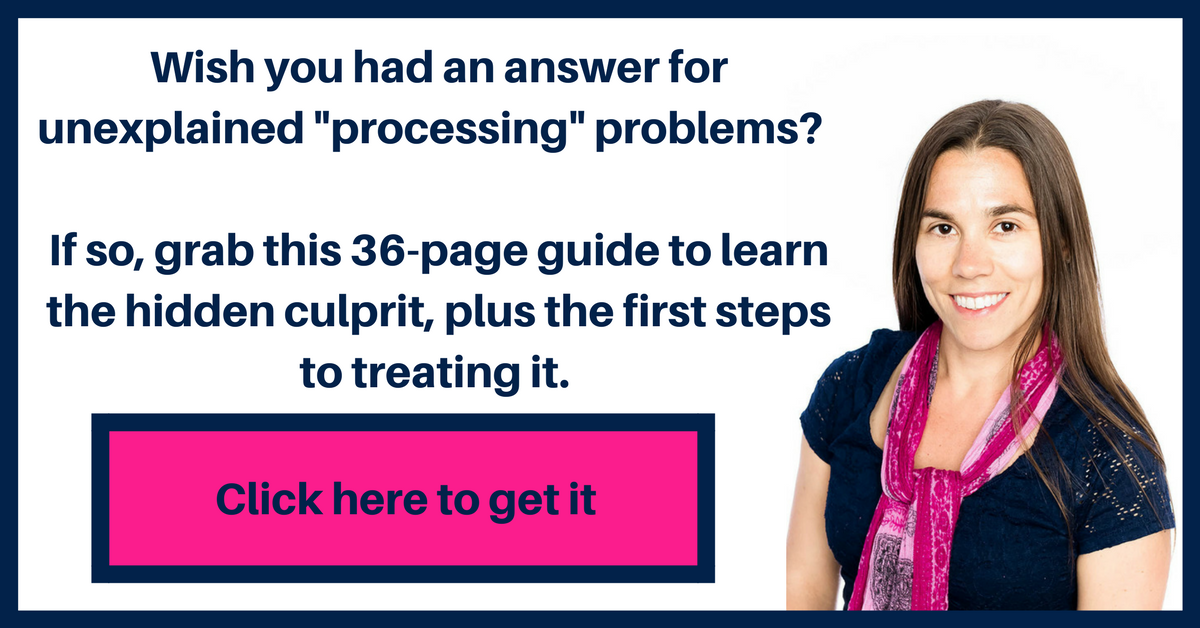If you struggle to write syntax goals for speech therapy, what you’re about to read will make your life substantially easier (spoiler alert: it involves a mini-IEP goal bank).
Do you have students who can’t get their ideas across and don’t “sound right” when they’re talking?
Maybe something sounds “off”, disorganized, or incomplete…but you can’t figure out what’s wrong?
If you have students like this, their problem might be related to syntax.
These are the kids teachers refer to you with “processing difficulties”.
Their reading and writing skills may be poor, and they struggle to follow directions.
As it turns out, this is no coincidence, because syntactic skills are proven to be correlated with reading and listening comprehension skills (Scott, 2009; Westby, 2012).
This makes perfect sense if you think about it. We won’t be able to understand sentences when we’re reading or heading them if we don’t understand how they’re put together.
Same goes for writing. If we don’t understand sentence structure, the sentences we say will be pretty disorganized.
Yet it can be really hard to write syntax goals for speech therapy; even if we’re using some type of IEP goal bank.
Why?
Well for me at least, I found it hard to teach syntactic results because I didn’t know them myself.
Let me rephrase. It’s not that I didn’t “know” them in the sense that I wasn’t able to communicate effectively.
It’s that I knew them so well IMPLICITLY, that I couldn’t explain them EXPLICITLY, which was what my students needed.
I was using all kinds of complex sentence structures because I intuitively knew how and when to use them…but I didn’t have the ability to explain what I was doing.
If you have this problem too, you’ll want to keep reading, because his post is the beginning of a five-article series for SLPs called Syntax Goals for Speech Therapy.
I’ll even promise what you could call an “IEP Goal Bank” for syntax that will come at the very end of the series.
To be honest, I hope to give you enough information about syntax goals that you won’t need an IEP goal bank. But I’ll still give it to you just in case you need it 🙂
Before we dive in to how exactly we should write syntax goals for speech therapy, we need to prioritize.
If your students are struggling with sentence structure, the list of error patterns they make can seem endless. We don’t have time to get to them all, nor do we need to.
That’s why for syntax, its necessary to examine the types of sentences that are MOST difficult to process, because these are the ones that will give our students with language impairments the biggest headaches.
Part of the reason I’m giving you the IEP goal bank at the end of the series is so I can make sure you know the high-priority skills first.
If we’re aware of the biggest culprits behind their processing difficulties, this can narrow our focus considerably. It can also make our therapy more effective, because we’re hitting the skills holding them back in the first place .
Thankfully, Dr. Richard Zipoli Jr. cleared up some confusion with an article he wrote in Intervention in School and Clinic. I came across it on Smart Speech Therapy’s Facebook page back in April of 2017 in this post. This article was also reviewed by Erickson Education Consulting in June 2017 as well in a blog post series. You can read the first post here.
Here’s the full reference:
Zipoli, R. P. (2017). Unraveling difficult sentences: Strategies to support reading comprehension, Intervention in School and Clinic 2017, 52, 218–227. doi: 10.1177/1053451216659465
The majority of this guide to writing syntax goals for speech therapy comes directly from this article (although you’ll see me cite a number of other sources as well).
One of our first steps to helping improve our students’ syntax is defining the biggest problems. They are:
Our students have a poor sense of sentence structure
They can’t get their ideas across effectively because they have disorganized language.
When they read, the books doesn’t make sense to them because the sentences are structured the way THEY would say them.
One of the best things an SLP can do to build syntax in speech therapy is to directly teach specific sentences structures; and that’s why the next four articles in the Syntax Goals for Speech Therapy will tell you exactly which sentence types to teach. According to Zipoli (2017), sentences with the following can be really difficult:
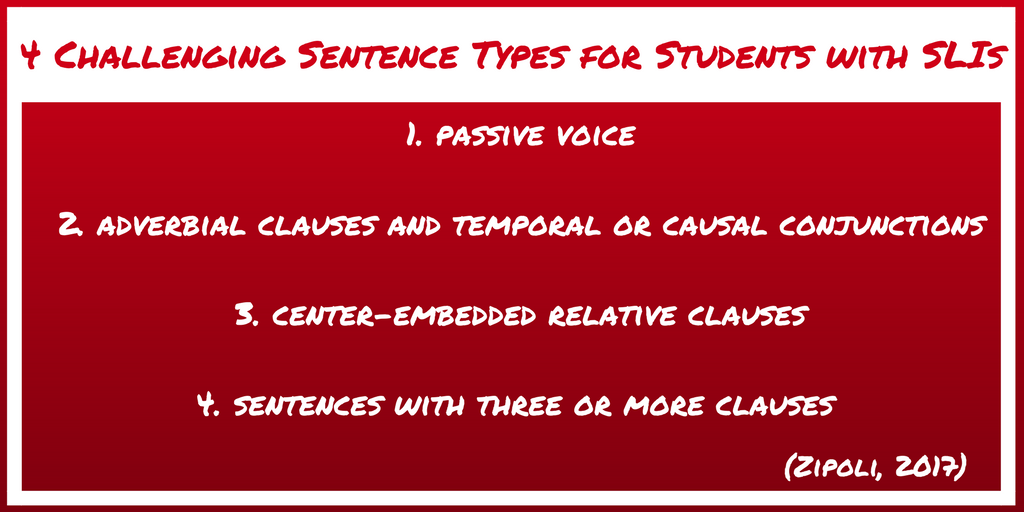
Before you start feeling overwhelmed or freaking out because you don’t know what these are off the top of your head…take a breath and relax.
I had to look some of these up too when I started working on them with my kiddos. You’re not a slacker because you don’t walk around all day thinking about center-embedding and relative pronouns 🙂
I promise it will all make sense by the time you get through the Syntax Goals for Speech Therapy series, because I’m going to dedicate an entire article a piece for each one of these four sentence types.
But…before we do any of that…I’m going to get on my soapbox about IEP goal banks for a minute.
Mostly because I hate them, and I’ve never used one (my “IEP goal bank” is in my head).
I think that over-reliance on IEP goal banks has caused us to focus too much on paperwork and can be a crutch for people who aren’t quite sure what skills they should be targeting.
Having said that, I do provide a version of an IEP goal bank for students of my Language Therapy Advance program, and I offer some mini-IEP goal banks within some of the free articles on my site.
I do this because I think using a list of goals as a swipe-file can keep you efficient. As long as you’re not using it as a crutch and you understand HOW to write good goals in the first place, I think they can be a useful tool. If you keep that in mind as you’re reading this series, I think you’ll end up being one of the select few who use IEP goal banks correctly.
With all that said, let’s get back to writing good syntax goals for speech therapy. The first step is knowing what you’re working on and how to track it.
When I write IEP goals for language, I typically start out with a “base goal.”
A base goal is a simple statement that identifies a behavior that you can physically observe. It’s pretty general, and it’s our starting point.
I use the mantra “If you can’t see someone doing it, you can’t track it”.
All of the IEP goal banks that I create start out with a few base goals, and you’d be surprised how little you need for language goals.
For example the IEP goal bank I give my Language Therapy Advance students only has six base language goals at this point, and it covers most of the skills you might need to address with school age children.
The base goal is key, because it helps to keep you focused on the “big picture”, and helps organize you as you sort through the massive number of syntax goals for speech therapy you COULD be working on.
My base goal for syntax is this:
“Student will say/write sentences.”
IT’S THAT SIMPLE. If you can remember this one insanely obvious behavior when writing your syntax goals, you are well ahead of the game.
Understanding those base behaviors is the “meat” of writing good goals, and it really is easier than most people think.
Your next step once you’ve identified the basic behavior you’re wanting to see is to customize your goal statement.
Let’s go back to that base goal behavior:
“Student will say/write sentences.”
If we want our student to say or write sentences correctly, there could be a number of different things we might want to see. We might want to see correct grammatical markers, or we might want to hear target vocabulary or sounds.
If we’re working on sentence structure we want to hear correct syntax, so the first obvious customization for syntax would look like this:
“Student will say/write sentences with appropriate syntax.”
You’d obviously want to make sure you add the appropriate level of accuracy at the end of it as well (e.g., “4 out of 5 trials”, “80% accuracy”).
Second, you’d consider whether you want to write a separate goal for oral vs. written language, or if you’d rather target them within the same goal. I’d say for syntax, that’s one of our biggest considerations.
To be honest, I usually favor efficiency. I’m more likely to write ONE GOAL for syntax, and target both oral and written within that goal. This way I can track and target them simultaneously in therapy.
I’ll admit here, that I’ve even combined syntax and grammar together because they are so interrelated, which could look like this:
“Student will say sentences with appropriate grammar/syntax on 4 out of 5 trials.”
I know a lot of people will fight me on the efficiency rule.
The drawback to going the “efficiency” route for goals is that sometimes students will only have met part of the goal; for example if they’ve met the goal for oral but not written.
But if that’s the case, I provide data for each one when tracking the goal. If it feels like I’m covering too much with one IEP goal, I tweak the goal as needed when I revise the IEP.
So far the IEP police haven’t thrown me in jail yet so I’m not losing sleep over this, especially because this drastically reduces the amount of time it takes me to write IEPs. I think time spent with students is a million times more valuable than time spent doing paperwork.
The point to take away from it is that when you are writing your syntax goals for speech therapy, you want to follow the KISS principle: Keep it simple, stupid.
The simpler your goals are, the easier to they will be to track. This means more time with your students and less time plugging away at your laptop writing reports.
As I wrap this first installment of Syntax Goals for Speech Therapy…let’s add that base goal to your IEP goal bank:
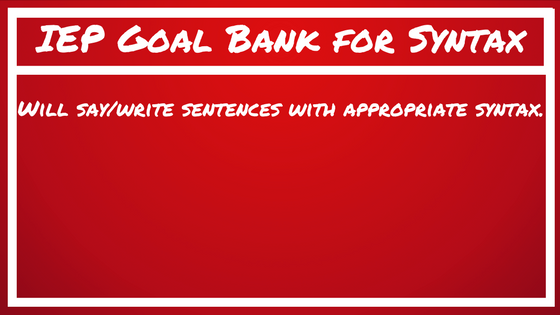
As we move through this series, we’ll add more to this IEP goal bank, so you’ll end up with a go-to list.
In the following articles in the Syntax Goals for Speech Therapy series, I’ll deconstruct those four problem sentence structures. I’ll also show you how to write syntax goals for each one and give you a research-based strategy to target it (straight from the Zipoli, 2017 article).
To get a complete guide on the most important syntactic skills and how to treat them, download this free guide for SLPs.
This free guide is called The Ultimate Guide to Sentence Structure.
Inside you’ll learn exactly how to focus your language therapy. Including:
- The hidden culprit behind unexplained “processing problems” that’s often overlooked.
- The deceptively simple way to write language goals; so you’re not spending hours on paperwork (goal bank included).
- The 4 sentence types often behind comprehension and expression issues and why they’re so difficult.
- An easy-to-implement “low-prep” strategy proven to boost sentence structure, comprehension, and written language (conjunctions flashcards included).
References:
